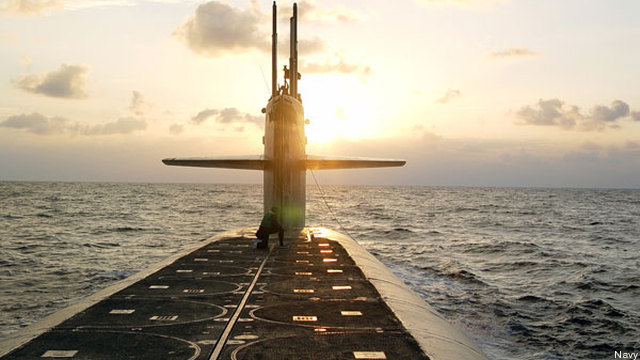Sub-Based Global Strike Weapon Reborn; Questions Remain
Posted on
 WASHINGTON: The Pentagon is again looking to its submarine fleet to fill a long-standing desire for a Prompt Global Strike weapon.
WASHINGTON: The Pentagon is again looking to its submarine fleet to fill a long-standing desire for a Prompt Global Strike weapon.
The Navy will finance work on an “undersea conventional prompt global strike option” as part of its share of DoD’s $525 billion budget request for Fiscal 2013, Defense Secretary Leon Panetta said during today’s press conference at the Pentagon. He did not go into detail on whether the weapon would be carried by the older Ohio-class submarines or the Virginia-class boats currently being built by the Navy. A PGS is a non-nuclear weapon designed to hit any target around the world within an hour. The only current weapons able to strike global targets that quickly are intercontinental nuclear missiles. Their numbers, range and warheads are strictly limited by various treaties, including the START treaties.
In mid-2000, the Navy tried to modify the D-5 Trident missile into a Prompt Global Strike weapon. However, Congress put an end to that. The strongest single opponent of the Trident modification plan at the time was Madelyn Creedon, former senior Senate Armed Services Committee staffer and now Assistant Secretary of Defense for Global Strategic Affairs. Creedon presumably will now defend sub-based PGS now that it is official Pentagon policy.
Lawmakers were concerned that a non-nuclear D-5 launch could be misinterpreted as a nuclear strike by U.S. allies, particularly Russia, and spark a nuclear counterstrike. But advances in missile technology development by DoD would ensure that no sub-launched PGS could ever be confused with a nuclear strike, Chairman of the Joint Chiefs of Staff Gen. Martin Dempsey said yesterday. Navy engineers could change the trajectory and speed of a PGS weapon to make it clear it was not a nuclear missile.
But the Pentagon’s sudden return to a sub-based PGS weapon was not prompted by any advanced in missile technology, according to a source with close ties to the defense and intelligence communities. “It [is] not a technical thing, but a political development,” the source said referring to the Russian counterstrike threat. That threat, the source added, was not as big a concern that many opponents of a sub-based conventional weapon had made it out to be.
Moscow and Washington have been at odds in recent months over nuclear weapon issues, particularly the White House’s plan for a missile defense shield in Eastern Europe. But something must have changed in that dynamic to give Pentagon leaders enough confidence to restart work on a sub-based PGS weapon, according to the source, who could not comment on what that change could have been. Whatever it was, the department is back on track to fill a much-needed combat capability, the source said.
A sub-based PGS is a “very sensible weapon” that would fill a particular niche in the Pentagon’s missile defense strategy, the source said. “It is a boutique weapon” the source added, noting U.S. forces would only need a handful to take out high-value targets at hypersonic speeds. “I wish to hell we had one when [Osama] Bin Laden was in Tora Bora,” he said, referring to the time when U.S. forces had Bin Laden pinned down in the mountain ranges along the Afghanistan-Pakistan border in 2001 and he escaped.
Subscribe to our newsletter
Promotions, new products and sales. Directly to your inbox.
